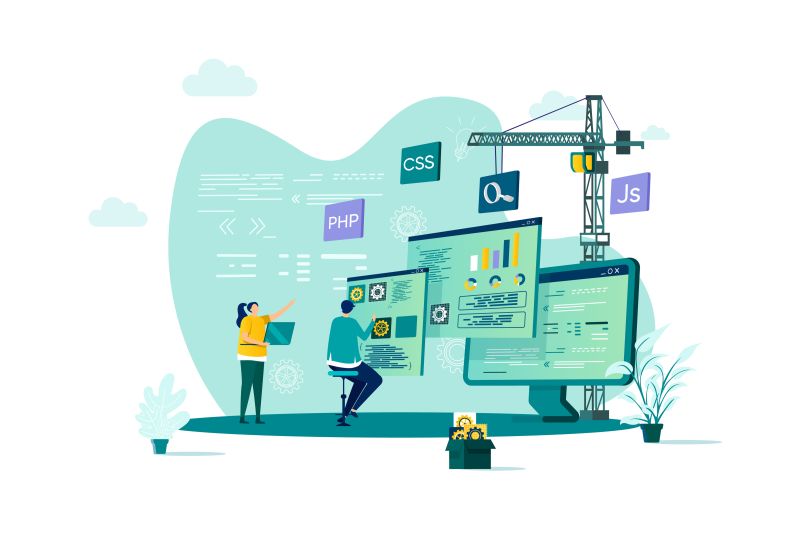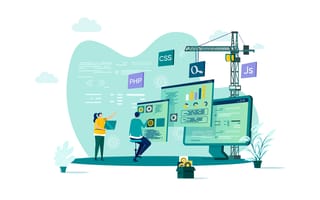
Because the tech landscape has evolved to a point where front-end and back-end technologies are becoming increasingly interlaced, the need for full-stack developers is on the rise.
So, what exactly does the role of a full-stack developer entail?
Cory Jbara, a software engineer at transportation technology company Arrive, said that it’s pivotal for full-stack developers to possess a well-rounded knowledge base in order to be able to jump into any project at any time.
In addition to being well-rounded, fintech company Supernova’s Full-Stack Engineer Henry Wu said that a full-stack developer needs to be a quick learner in order to get up to speed quickly and be capable of making significant contributions to projects in short order.
Furthermore, the role of a full-stack developer entails being flexible and wearing many different hats within the organization in order to better serve customers, said Marielle Billig, software developer at education technology platform RedShelf.
It’s clear that full-stack developers play a crucial role at tech organizations thanks to their flexibility and knowledge across the entire development process. Built In Chicago recently checked in with Jbara, Wu, Billig and five more leaders across the city to learn more about the role full-stack developers play at each of their companies.
Artificial intelligence company Narrative Science helps companies better understand their consumer data and insights using “data storytelling technologies.” Michael Smathers, a principal software engineer, said that there are many opportunities for full-stack developers to move across the stack.
What role does a full-stack developer typically play at your company?
There are numerous opportunities for a full-stack developer to make a big impact on our technology. Our stack includes everything from cloud services such as Amazon Web Services and CircleCI, to Python and AsyncIOback end REST API microservices, React front ends and everything in between. Our authoring engine involves a number of more academic pursuits including designing composable parse trees and graph modeling or traversal. Building platform features often involves implementing brand new back end Async workers, status and configuration API endpoints, and Redux and React front ends, all of which can be designed and built by full-stack engineers.
Our recent work to support Tableau dashboard data sources has been perfect for a full-stack skillset. Over the course of two weeks, I extended our platform to securely store external authentication credentials, implemented data ingestion logic to query file-based Tableau data dumps and stream result sets to S3, and built out a “connection status” UI that polls data-loading endpoints to inform the end user about data ingestion progress.
Beyond this specific project, our team encourages rapid prototyping of new capabilities to explore and de-risk potential roadmap items. These are great opportunities for full-stack developers to quickly move up and down the stack with a hackathon-like mentality of sprinting towards a minimally-viable product (MVP) that will wow the team and company-wide stakeholders.
Our team encourages rapid prototyping of new capabilities to explore and de-risk potential roadmap items.”
What’s an interesting project you’re currently working on?
We’re currently building out support for Tableau dashboards as a data source for Lexio, our data storytelling platform. Unlocking this capability will greatly expand our potential user base while reducing integration time and cost at the same time. By sitting on top of Tableau, our platform can leverage an organization’s existing data pipelining infrastructure to achieve product value in minutes, rather than days of back and forth between cloud-ops and IT teams.
The challenges and learnings from this project have been numerous. The mechanics of Tableau data ingestion at scale involves orchestrating three separate APIs and libraries, including the use of a new piece of technology that required us to upgrade our build system. We rapidly prototyped a novel data loading UI, which we jokingly call “the most elaborate loading spinner ever built.” It displays portions of metadata and raw data in the browser as they become available, giving the end user insight into what’s happening under the hood. Perhaps the biggest learning from this project has been to conceptually decouple metadata and schema ingestion from ingestion of the full, raw dataset. While this happened out of necessity, we realized that this decoupling would allow for more future flexibility when pipelining new types of data sources.
Kin + Carta offers clients three main services: software engineering, consultancy and digital marketing and branding. Full-Stack Developer Vince Hétet said that at Kin + Carta, full-stack developers have lots of opportunities to jump into new positions in order to work together as a team.
What role does a full-stack developer typically play at your company?
As a consultant, I deal with a pretty wide variety of projects, industries and tech stacks. This means that full-stack developers at Kin + Carta regularly have the opportunity to jump into back-end or front-end positions. On a recent project, we were building a web application for a client in the healthcare industry, specifically a front-end application for their employees. After a few months of development, it became clear that the back-end team needed support. Alongside a few of my teammates, we were able to provide that support immediately.
While it has its challenges, it’s been extremely rewarding to see that I can leverage my experience and quickly have an impact on my team.”
What’s an interesting project you’re currently working on?
I am working on a project to build an e-commerce web platform for farming products. When I joined the team, I was new to tech stack and most of the industry. While it has its challenges, it’s been extremely rewarding to see that I can leverage my experience and quickly have an impact on my team. I feel like I am always learning new things, which I enjoy.
Fintech company Supernova offers a cloud-based, fully-customizable, end-to-end software solution that automates securities-based lending. Full-Stack Developer Henry Wu said that while he wears a lot of hats in his position, it’s rewarding to be able to solve any challenges that come his way.
What role does a full-stack developer typically play at your company?
A full-stack developer is responsible for communicating and analyzing user requirements, authorizing functional requirement documentation and workflows, building wireframes and interactive prototypes, and then helping implement web applications with the broader team.
Smart Analytics is a recent project at Supernova that not only relied heavily on a full-stack engineer’s ability to work on both front-end and back-end implementations, but also to build an effective communication process across internal clients. In addition, a full-stack developer needs to be a quick learner in order to get up to speed quickly and be capable of making significant contributions to projects in short order. Most importantly, they need to be effective at bringing different team members, or even teams, together to collaborate on projects and arrive at solutions together.
It’s rewarding to wear so many hats. I am the full-stack developer overseeing an entire web application at Supernova. At other companies, I might be in charge of one page or just one feature. Plus, we are growing and evolving our platform at a fast pace, which leads to many challenges for an engineer to solve — which I also find rewarding.
We are constantly learning and making our product better every day.”
What’s an interesting project you’re currently working on?
One of the projects I am currently working on is called Smart Analytics. It’s our next flagship product that provides reporting, monitoring and analysis to our customers that use our securities-based lending (SBL) technology platform for wealth lending. It enables customers to easily see all kinds of useful business intelligence analyses and reports based on a wide array of loan data. The goal is to build a powerful data platform where our customers can drill down and answer all kinds of questions with data.
This project was challenging because it is a brand new product and we had to build everything from the ground up. As a full-stack engineer, I not only had to work on the back-end implementation but also worked closely with the product manager and user experience designer on the front-end design. Being able to collaborate with different groups of people to understand the business needs while working closely with the engineers on all kinds of technical problems is quite challenging. However, it’s those challenges that make it so special and attractive to work at Supernova, and we are constantly learning and making our product better every day.
One North is a full-service digital agency that helps clients solve complex problems in creative ways. Because of their abilities to work on the back or front end, full-stack developers at One North provide each project with a lot of flexibility, Front-End Architect Jimmy Tsao said.
What role does a full-stack developer typically play at your company?
Full-stack developers are highly valued at One North for their knowledge across the stack and are usually in senior roles on a project team. On a recent project, the full-stack developer on the team played a key role in architecting solutions for business requirements and led a team of front-end and back-end developers on the implementation. The full-stack developer provided the project with a lot of flexibility by being able to work on the back end or front end, depending on the needs of the project. When issues arose, the full-stack developer quickly diagnosed which layers in the stack were involved and coordinated with the corresponding developers to resolve.
I get to work with a talented team to think through and solve challenges.”
What’s an interesting project you’re currently working on?
I’m currently building a digital experience for a client using a headless CMS architecture. The approach that we’re using is new and different from how One North has traditionally built websites, so this inherently introduces a lot of interesting engineering challenges. The best part is that I get to work with a talented team to think through and solve these challenges while knowing that our solutions and decisions will have an influence on how One North approaches these types of projects moving forward.
IT consulting firm Carminati Consulting provides clients unique solutions to software application development, website design, data analytics and project management. Currently, developers at Carminati are working on a software solution called Immuware, which Director of Software Development Michael Brower said is his most rewarding project yet.
What role does a full-stack developer typically play at your company?
Full-stack developers truly get to work across the stack at Carminati. From interfacing with the database through Entity Framework to implementing the business logic and massaging the data through .Net, and displaying and interacting with the data on the front end through Bootstrap and jQuery, there are opportunities to work on it all.
You don’t have to look any further than Immuware and the integration module (mentioned below). Our developers had to write the queries to read and write the external data to the Immuware database. They had to write the code to handle the logic of translating the mapping data, building a payload file and establishing the transmission frequency. Finally, they had to implement the front end in a way that was intuitive to our business analysts so that they can easily map the data.
Our integrations module has put us in a good place to meet the timeline challenge and provide excellent service to our clients.”
What’s an interesting project you’re currently working on?
We are currently working on a project to integrate our SaaS solution, Immuware, with a third-party company that will report vaccination information, including the upcoming COVID-19 vaccine, to state registries. This integration project has many technical components that are the culmination of months of development to build a custom “integration module,” as we’ve dubbed it. Our custom integration module lays out the framework for querying or writing the data, translating the data, building or reading a payload file containing the data, transmitting the data file and setting the frequency in which to transmit the data. One of the biggest challenges when integrating data is understanding the data itself, including the formats and how they are similar or different between both systems.
The state registry integration project in particular has been challenging primarily because of the aggressive deadline to have everything in place in preparation for the release of the first emergency use COVID-19 vaccines. Our integrations module has put us in a good place to meet the timeline challenge and provide excellent service to our clients. Beyond that, this project is rewarding in a way that I’ve never felt before. Not only does it feel like we are on the cutting edge of providing critical data to state registries in order to assist with the ongoing development of a vaccine, but we have set ourselves up to meet this challenge head-on with the extraordinary work our development team has done and continues to do.
Education technology company RedShelf helps make education more affordable and effective through digital course materials. Because most of the features RedShelf offers contain front- and back-end work, Software Engineer Marielle Billig said that it’s important for developers to wear many hats.
What role does a full-stack developer typically play at your company?
A full-stack engineer often wears many hats at RedShelf. Nearly every feature our team adds has an element of front- and back-end work, so it’s extremely advantageous to have an understanding of both. Design and user experience are huge aspects of front-end development and I believe that the practice of putting the user first also informs my back-end work, which leads to an improved product overall.
I love the process of seeing an idea for a product progress to an actual web page and making it come alive under my hands.”
What’s an interesting project you’re currently working on?
We’re currently working on building a suite of tools that allow our partners to manage their catalogs directly. I love the process of seeing an idea for a product progress to an actual web page and making it come alive under my hands. It’s exciting to see the things I work on “in the wild” and hear that they’re making people’s lives a little bit easier.
Topstep is a trading platform that enables aspiring traders to learn how to manage risk, gain confidence and trade capital without putting their life savings on the line. In order to keep up with increased scalability, Platform Engineer Will Sanders said Topstep’s developers are working on a new cloud-native infrastructure.
What role does a full-stack developer typically play at your company?
Though my expertise lies more on the back-end side of things, we encourage as much ownership as possible. The shift we’re making to a new cloud-native architecture creates a lot of opportunities to establish patterns at a foundational level. And, based on an individual team member’s comfort level, there’s also plenty of opportunity for CI/CD pipelines, infrastructure as code, data modeling in both relational and NoSQL environments, APIs, back-end systems and foundational front-end patterns.
Our new upgrades will enable us to scale and continue to iterate on our product at a more rapid pace.”
We often leverage a full stack developer’s expertise across an entire project. A perfect example of this would be our data processing. We started by establishing the infrastructure using infrastructure-as-code tooling. Then, we performed data modeling for tracking the processing state and wrote all of the back-end code using Node.js and TypeScript to establish organizational patterns along the way. To bring it all together, we employed a suite of unit tests and end-to-end tests against the live test-bed infrastructure to ensure our codebase was strong and resilient against change.
Leveraging AWS Managed Services is a massive benefit to a small team like ours, hence the migration. It helps keep the complexity levels low and allows individuals to have a much more significant role across the project.
What’s an interesting project you’re currently working on?
As Topstep continues to grow, one of the biggest challenges we face is increasing scalability. Building segregated applications makes it difficult to keep pace with increasing demand. Right now, we’re laying the foundation and establishing patterns for a new cloud-native infrastructure to adopt moving forward. This will allow us to be more elastic and give every project team access to the infrastructure they need when they need it.
This project will involve moving away from a monolithic Rails web application hosted on a server and move to a distributed, event-driven architecture using AWS. We have already adopted a handful of microservices that are currently being consumed in production as well as an entirely new means to process data. These upgrades will enable us to scale and continue to iterate on our product at a more rapid pace.
Arrive delivers users last-mile mobility solutions to navigation systems, voice platforms, websites, mobile apps and in-car dashboards, instantly connecting drivers with a network of spaces. Software Engineer Cory Jbara said that it’s pivotal for Arrive’s developers to have a well-rounded knowledge base in order to be able to pick up any project that needs work.
What role does a full-stack developer typically play at your company?
At Arrive, we have many engineers who are able to work across all parts of the stack. From back-end development on highly scalable systems to new feature design and front-end interface building, it’s pivotal that our engineers have the skills to pick up any project that needs to be done.
Because we have such a talented, versatile team, the back-end and front-end development on a feature is often completed by the same engineer, which allows us to move quickly to roll out new products and features on our platform. For example, I helped develop a lightweight API for our “Tap, Pay, Park” product, and now I am iterating on the corresponding web interface to make the checkout process much simpler for our users.
Our team has a great sense of trust in each other, and we are confident that no matter who does the work for a new feature, it will meet our high standards of excellence.
Though technology will continue to become more integrated and intertwined, it’s pivotal that we maintain our focus on the ease of use of our products.”
What’s an interesting project you’re currently working on?
I am currently working on our newest product called Tap, Pay, Park, which allows users to tap an NFC tag or scan a QR code in a parking garage and be dropped into a context-driven checkout flow, where they simply need to click a button to pay for parking.
One of the biggest challenges in technology these days is managing the complexity of integrations. Oftentimes this complexity comes at the expense of users, who have to navigate through cluttered interfaces to accomplish even the smallest task.
Though technology will continue to become more integrated and intertwined, it’s pivotal that we maintain our focus on the ease of use of our products. We must hide the inevitable complexity behind a simple interface because that’s what users want. As a company that is pioneering the bridge between the physical world and digital payments, we have a duty to serve our customers with good interfaces. Tap, Pay, Park is our way of getting back to basics, providing a frictionless solution to our customers, and we hope it will inspire other companies to follow our lead to make user experiences as simple as possible.



















